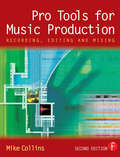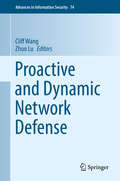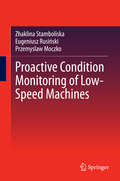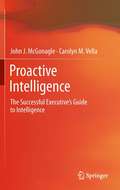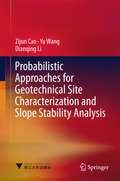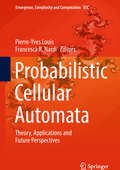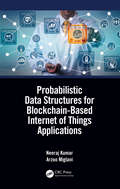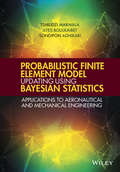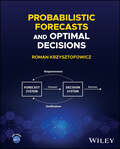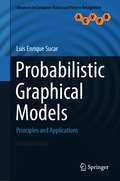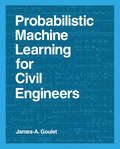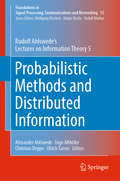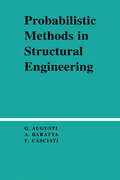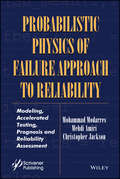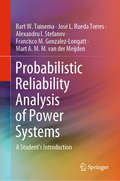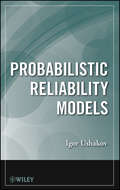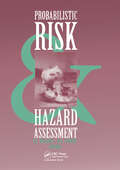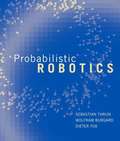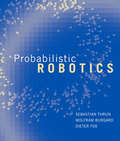- Table View
- List View
Pro Tools for Music Production: Recording, Editing and Mixing
by Mike CollinsPro Tools for Music Production is a definitive guide to the system for new and professional users. Extensively illustrated in colour and packed with time saving hints and tips, you will want to keep to hand as a constant source of information. The book takes a real-world approach and shows how to build the right system to suit your needs. Detailed chapters on recording, editing and mixing blend essential knowledge with tutorials and practical examples from actual recordings. The second edition features a wealth of new and updated material, including: · Pro Tools HD systems explained· Pro Tools 6.1 software (and up to version 6.2.3)· Mac OSX installation and troubleshooting· A new chapter on MIDI· Additional and expanded tutorials· More on Identify Beat, Beat Detective and tempo maps· Extra coverage of plug-ins and virtual instruments· How to use Propellerheads Reason and Ableton Live with Pro Tools· What you need to know about the new file management capabilities· How to transfer projects between Pro Tools and other MIDI and audio software, and between Pro Tools TDM on the Mac and Pro Tools LE on the PCPro Tools for Music Production is a vital source of reference to keep by your side, whether you are a working professional or a serious hobbyist looking for professional results.
Pro Tools LE and M-Powered: The complete guide
by Mike CollinsPro Tools LE and M-Powered is an authoritative guide to Digidesign's entry-level hardware and software systems. Illustrated throughout with color screen grabs, the book starts by giving you useful overviews and advice about the hardware options available. Subsequent chapters are packed with easy-to-follow instructions, valuable hints and time-saving tips on how to use the software. Includes:* Full coverage of all new features in version 7* Information on tempos, clicks and grooves* Two chapters on MIDI* Useful tutorials on using Reason, Live and SampleTank* Recommendations on backups and transfers* Guidance on the DV Toolkit for post productionFor troubleshooting technical problems, advice on purchasing decisions or inspiration for new ideas, keep this book by your side as a vital reference point.
The PROACT® Root Cause Analysis: Quick Reference Guide (Reliability, Maintenance, and Safety Engineering)
by Kenneth C. Latino Mark A. Latino Robert J. LatinoRoot Cause Analysis, or RCA, "What is it?" Everyone uses the term, but everyone does it differently. How can we have any uniformity in our approach, much less accurately compare our results, if we’re applying different definitions? At a high level, we will explain the difference between RCA and Shallow Cause Analysis, because that is the difference between allowing a failure to recur or dramatically reducing the risk of recurrence.In this book, we will get down to basics about RCA, the fundamentals of blocking and tackling, and explain the common steps of any investigative occupation. Common investigation steps include: Preserving evidence (data)/not allowing hearsay to fly as fact Organizing an appropriate team/minimizing potential bias Analyzing the events/reconstructing the incident based on actual evidence Communicating findings and recommendations/ensuring effective recommendations are actually developed and implemented Tracking bottom-line results/ensuring that identified, meaningful metrics were attained We explore, "Why don’t things always go as planned?" When our actual plans deviate from our intended plans, we usually experience some type of undesirable or unintended outcome. We analyze the anatomy of a failure (undesirable outcome) and provide a step-by-step guide to conducting a comprehensive RCA based on our 3+ decades of applying RCA as we have successfully practiced it in the field. This book is written as a how-to guide to effectively apply the PROACT® RCA methodology to any undesirable outcome, is directed at practitioners who have to do the real work, focuses on the core elements of any investigation, and provides a field-proven case as a model for effective application. This book is for anyone charged with having a thorough understanding of why something went wrong, such as those in EH&S, maintenance, reliability, quality, engineering, and operations to name just a few.
Proactive and Dynamic Network Defense (Advances in Information Security #74)
by Cliff Wang Zhuo LuThis book discusses and summarizes current research issues, identifies challenges, and outlines future directions for proactive and dynamic network defense. This book also presents the latest fundamental research results toward understanding proactive and dynamic network defense by top researchers in related areas. It includes research results that offer formal frameworks to define proactive and dynamic network defense, and develop novel models to analyze and evaluate proactive designs and strategies in computer systems, network systems, cyber-physical systems and wireless networks. A wide variety of scientific techniques have been highlighted to study these problems in the fundamental domain. As the convergence of our physical and digital worlds grows fast pace, protecting information systems from being tampered or unauthorized access is becoming one of the most importance issues. The traditional mechanisms of network defense are built upon a static, passive, and reactive nature, which has insufficient to defend against today's attackers that attempt to persistently analyze, probe, circumvent or fool such mechanisms. It has not yet been fully investigated to address the early stage of “cyber kill chain” when adversaries carry out sophisticated reconnaissance to plan attacks against a defense system. Recently, proactive and dynamic network defense has been proposed as an important alternative towards comprehensive network defense. Two representative types of such defense are moving target defense (MTD) and deception-based techniques. These emerging approaches show great promise to proactively disrupt the cyber-attack kill chain and are increasingly gaining interest within both academia and industry. However, these approaches are still in their preliminary design stage. Despite the promising potential, there are research issues yet to be solved regarding the effectiveness, efficiency, costs and usability of such approaches. In addition, it is also necessary to identify future research directions and challenges, which is an essential step towards fully embracing proactive and dynamic network defense. This book will serve as a great introduction for advanced-level computer science and engineering students who would like to start R&D efforts in the field of proactive and dynamic network defense. Researchers and professionals who work in this related field will also find this book useful as a reference.
Proactive Condition Monitoring of Low-Speed Machines
by Zhaklina Stamboliska Eugeniusz Rusiński Przemyslaw MoczkoThis book broadens readers' understanding of proactive condition monitoring of low- speed machines in heavy industries. It focuses on why low-speed machines are different than others and how maintenance of these machines should be implemented with particular attention. The authors explain the best available monitoring techniques for various equipment and the principle of how to get proactive information from each technique. They further put forward possible strategies for application of FEM for detection of faults and technical assessment of machinery. Implementation phases are described and industrial case studies of proactive condition monitoring are included. Proactive Condition Monitoring of Low-Speed Machines is an essential resource for engineers and technical managers across a range of industries as well as design engineers working in industrial product development.
Proactive Intelligence
by John J. Mcgonagle Carolyn M. VellaTraditionally, tapping into the power of competitive intelligence (CI) meant investing in the development of an internal CI unit or hiring outside consultants who specialized in CI. Proactive Intelligence: The Successful Executive's Guide to Intelligence offers an alternative: learn how to do it yourself and how to effectively manage the parts you cannot. The tools and techniques that will enable you to produce your own CI for your consumption are out there, and have been honed by decades of work. But, you cannot just adopt them - you have to adapt them. Why? Because, when you finish reading this book, you will be the data collector, the analyst, and the end-user. Traditional CI is premised on a reactive, two part relationship - a CI professional responding to what an end-user identifies as a need; by doing this yourself you can turn CI from being reactive to being proactive. As the decision-maker, you can get what CI you need, when you need it, and then use it almost seamlessly. Written by two of the foremost experts on CI, Proactive Intelligence: The Successful Executive's Guide to Intelligence: shows where and how CI can help you and your firm, provides practical guidance on how to identify what CI you need, how to find the data you need, and how to analyze it, and discusses how to apply CI to develop competitive- and career- advantages. Each chapter is supported by important references as well as by an additional list of resources to support and supplement your knowledge. Proactive Intelligence: The Successful Executive's Guide to Intelligence teaches you how to generate proactive intelligence and use it to advance your business and your career- making it an essential resource for managers and executives, as well as everyone who wishes to integrate CI into their daily work routine.
Probabilistic Approaches for Geotechnical Site Characterization and Slope Stability Analysis
by Dianqing Li Yu Wang Zijun CaoThis is the first book to revisit geotechnical site characterization from a probabilistic point of view and provide rational tools to probabilistically characterize geotechnical properties and underground stratigraphy using limited information obtained from a specific site. This book not only provides new probabilistic approaches for geotechnical site characterization and slope stability analysis, but also tackles the difficulties in practical implementation of these approaches. In addition, this book also develops efficient Monte Carlo simulation approaches for slope stability analysis and implements these approaches in a commonly available spreadsheet environment. These approaches and the software package are readily available to geotechnical practitioners and alleviate them from reliability computational algorithms. The readers will find useful information for a non-specialist to determine project-specific statistics of geotechnical properties and to perform probabilistic analysis of slope stability.
Probabilistic Cellular Automata: Theory, Applications And Future Perspectives (Emergence, Complexity And Computation Ser. #27)
by Pierre-Yves Louis Francesca R. NardiThis book explores Probabilistic Cellular Automata (PCA) from the perspectives of statistical mechanics, probability theory, computational biology and computer science. PCA are extensions of the well-known Cellular Automata models of complex systems, characterized by random updating rules. Thanks to their probabilistic component, PCA offer flexible computing tools for complex numerical constructions, and realistic simulation tools for phenomena driven by interactions among a large number of neighboring structures. PCA are currently being used in various fields, ranging from pure probability to the social sciences and including a wealth of scientific and technological applications. This situation has produced a highly diversified pool of theoreticians, developers and practitioners whose interaction is highly desirable but can be hampered by differences in jargon and focus. This book – just as the workshop on which it is based – is an attempt to overcome these difference and foster interest among newcomers and interaction between practitioners from different fields. It is not intended as a treatise, but rather as a gentle introduction to the role and relevance of PCA technology, illustrated with a number of applications in probability, statistical mechanics, computer science, the natural sciences and dynamical systems. As such, it will be of interest to students and non-specialists looking to enter the field and to explore its challenges and open issues.
Probabilistic Data Structures for Blockchain-Based Internet of Things Applications
by Neeraj Kumar Arzoo MiglaniThis book covers theory and practical knowledge of Probabilistic data structures (PDS) and Blockchain (BC) concepts. It introduces the applicability of PDS in BC to technology practitioners and explains each PDS through code snippets and illustrative examples. Further, it provides references for the applications of PDS to BC along with implementation codes in python language for various PDS so that the readers can gain confidence using hands on experience. Organized into five sections, the book covers IoT technology, fundamental concepts of BC, PDS and algorithms used to estimate membership query, cardinality, similarity and frequency, usage of PDS in BC based IoT and so forth.
Probabilistic Finite Element Model Updating Using Bayesian Statistics: Applications to Aeronautical and Mechanical Engineering
by Tshilidzi Marwala Ilyes Boulkaibet Sondipon AdhikariProbabilistic Finite Element Model Updating Using Bayesian Statistics: Applications to Aeronautical and Mechanical Engineering Tshilidzi Marwala and Ilyes Boulkaibet, University of Johannesburg, South Africa Sondipon Adhikari, Swansea University, UK Covers the probabilistic finite element model based on Bayesian statistics with applications to aeronautical and mechanical engineering Finite element models are used widely to model the dynamic behaviour of many systems including in electrical, aerospace and mechanical engineering. The book covers probabilistic finite element model updating, achieved using Bayesian statistics. The Bayesian framework is employed to estimate the probabilistic finite element models which take into account of the uncertainties in the measurements and the modelling procedure. The Bayesian formulation achieves this by formulating the finite element model as the posterior distribution of the model given the measured data within the context of computational statistics and applies these in aeronautical and mechanical engineering. Probabilistic Finite Element Model Updating Using Bayesian Statistics contains simple explanations of computational statistical techniques such as Metropolis-Hastings Algorithm, Slice sampling, Markov Chain Monte Carlo method, hybrid Monte Carlo as well as Shadow Hybrid Monte Carlo and their relevance in engineering. Key features: Contains several contributions in the area of model updating using Bayesian techniques which are useful for graduate students. Explains in detail the use of Bayesian techniques to quantify uncertainties in mechanical structures as well as the use of Markov Chain Monte Carlo techniques to evaluate the Bayesian formulations. The book is essential reading for researchers, practitioners and students in mechanical and aerospace engineering.
Probabilistic Forecasts and Optimal Decisions
by Roman KrzysztofowiczAccount for uncertainties and optimize decision-making with this thorough exposition Decision theory is a body of thought and research seeking to apply a mathematical-logical framework to assessing probability and optimizing decision-making. It has developed robust tools for addressing all major challenges to decision making. Yet the number of variables and uncertainties affecting each decision outcome, many of them beyond the decider’s control, mean that decision-making is far from a ‘solved problem’. The tools created by decision theory remain to be refined and applied to decisions in which uncertainties are prominent. Probabilistic Forecasts and Optimal Decisions introduces a theoretically-grounded methodology for optimizing decision-making under conditions of uncertainty. Beginning with an overview of the basic elements of probability theory and methods for modeling continuous variates, it proceeds to survey the mathematics of both continuous and discrete models, supporting each with key examples. The result is a crucial window into the complex but enormously rewarding world of decision theory. Readers of Probablistic Forecasts and Optimal Decisions will also find: Extended case studies supported with real-world dataMini-projects running through multiple chapters to illustrate different stages of the decision-making processEnd of chapter exercises designed to facilitate student learning Probabilistic Forecasts and Optimal Decisions is ideal for advanced undergraduate and graduate students in the sciences and engineering, as well as predictive analytics and decision analytics professionals.
Probabilistic Graphical Models: Principles and Applications (Advances in Computer Vision and Pattern Recognition)
by Luis Enrique SucarThis fully updated new edition of a uniquely accessible textbook/reference provides a general introduction to probabilistic graphical models (PGMs) from an engineering perspective. It features new material on partially observable Markov decision processes, graphical models, and deep learning, as well as an even greater number of exercises.The book covers the fundamentals for each of the main classes of PGMs, including representation, inference and learning principles, and reviews real-world applications for each type of model. These applications are drawn from a broad range of disciplines, highlighting the many uses of Bayesian classifiers, hidden Markov models, Bayesian networks, dynamic and temporal Bayesian networks, Markov random fields, influence diagrams, and Markov decision processes.Topics and features:Presents a unified framework encompassing all of the main classes of PGMsExplores the fundamental aspects of representation, inference and learning for each techniqueExamines new material on partially observable Markov decision processes, and graphical modelsIncludes a new chapter introducing deep neural networks and their relation with probabilistic graphical models Covers multidimensional Bayesian classifiers, relational graphical models, and causal modelsProvides substantial chapter-ending exercises, suggestions for further reading, and ideas for research or programming projectsDescribes classifiers such as Gaussian Naive Bayes, Circular Chain Classifiers, and Hierarchical Classifiers with Bayesian NetworksOutlines the practical application of the different techniquesSuggests possible course outlines for instructorsThis classroom-tested work is suitable as a textbook for an advanced undergraduate or a graduate course in probabilistic graphical models for students of computer science, engineering, and physics. Professionals wishing to apply probabilistic graphical models in their own field, or interested in the basis of these techniques, will also find the book to be an invaluable reference.Dr. Luis Enrique Sucar is a Senior Research Scientist at the National Institute for Astrophysics, Optics and Electronics (INAOE), Puebla, Mexico. He received the National Science Prize en 2016.
Probabilistic Machine Learning for Civil Engineers
by James-A. GouletAn introduction to key concepts and techniques in probabilistic machine learning for civil engineering students and professionals; with many step-by-step examples, illustrations, and exercises.This book introduces probabilistic machine learning concepts to civil engineering students and professionals, presenting key approaches and techniques in a way that is accessible to readers without a specialized background in statistics or computer science. It presents different methods clearly and directly, through step-by-step examples, illustrations, and exercises. Having mastered the material, readers will be able to understand the more advanced machine learning literature from which this book draws.The book presents key approaches in the three subfields of probabilistic machine learning: supervised learning, unsupervised learning, and reinforcement learning. It first covers the background knowledge required to understand machine learning, including linear algebra and probability theory. It goes on to present Bayesian estimation, which is behind the formulation of both supervised and unsupervised learning methods, and Markov chain Monte Carlo methods, which enable Bayesian estimation in certain complex cases. The book then covers approaches associated with supervised learning, including regression methods and classification methods, and notions associated with unsupervised learning, including clustering, dimensionality reduction, Bayesian networks, state-space models, and model calibration. Finally, the book introduces fundamental concepts of rational decisions in uncertain contexts and rational decision-making in uncertain and sequential contexts. Building on this, the book describes the basics of reinforcement learning, whereby a virtual agent learns how to make optimal decisions through trial and error while interacting with its environment.
Probabilistic Mapping of Spatial Motion Patterns for Mobile Robots (Cognitive Systems Monographs #40)
by Tomasz Piotr Kucner Achim J. Lilienthal Martin Magnusson Luigi Palmieri Chittaranjan Srinivas SwaminathanThis book describes how robots can make sense of motion in their surroundings and use the patterns they observe to blend in better in dynamic environments shared with humans.The world around us is constantly changing. Nonetheless, we can find our way and aren’t overwhelmed by all the buzz, since motion often follows discernible patterns. Just like humans, robots need to understand the patterns behind the dynamics in their surroundings to be able to efficiently operate e.g. in a busy airport. Yet robotic mapping has traditionally been based on the static world assumption, which disregards motion altogether. In this book, the authors describe how robots can instead explicitly learn patterns of dynamic change from observations, store those patterns in Maps of Dynamics (MoDs), and use MoDs to plan less intrusive, safer and more efficient paths. The authors discuss the pros and cons of recently introduced MoDs and approaches to MoD-informed motion planning, and provide an outlook on future work in this emerging, fascinating field.
Probabilistic Mechanics of Quasibrittle Structures: Strength, Lifetime, and Size Effect
by Zdeněk P. Bažant Jia-Liang LeQuasibrittle (or brittle heterogeneous) materials are becoming increasingly important for modern engineering. They include concretes, rocks, fiber composites, tough ceramics, sea ice, bone, wood, stiff soils, rigid foams, glass, dental and biomaterials, as well as all brittle materials on the micro or nano scale. Their salient feature is that the fracture process zone size is non-negligible compared to the structural dimensions. This causes intricate energetic and statistical size effects and leads to size-dependent probability distribution of strength, transitional between Gaussian and Weibullian. The ensuing difficult challenges for safe design are vanquished in this book, which features a rigorous theory with detailed derivations yet no superfluous mathematical sophistication; extensive experimental verifications; and realistic approximations for design. A wide range of subjects is covered, including probabilistic fracture kinetics at nanoscale, multiscale transition, statistics of structural strength and lifetime, size effect, reliability indices, safety factors, and ramification to gate dielectrics breakdown.
Probabilistic Methods and Distributed Information: Rudolf Ahlswede’s Lectures on Information Theory 5 (Foundations in Signal Processing, Communications and Networking #15)
by Rudolf Ahlswede Alexander Ahlswede Ingo Althöfer Christian Deppe Vladimir Blinovsky Ulrich Tamm Holger Boche Ulrich Krengel Ahmed MansourThe fifth volume of Rudolf Ahlswede’s lectures on Information Theory focuses on several problems that were at the heart of a lot of his research. One of the highlights of the entire lecture note series is surely Part I of this volume on arbitrarily varying channels (AVC), a subject in which Ahlswede was probably the world's leading expert. Appended to Part I is a survey by Holger Boche and Ahmed Mansour on recent results concerning AVC and arbitrarily varying wiretap channels (AVWC). After a short Part II on continuous data compression, Part III, the longest part of the book, is devoted to distributed information. This Part includes discussions on a variety of related topics; among them let us emphasize two which are famously associated with Ahlswede: "multiple descriptions", on which he produced some of the best research worldwide, and "network coding", which had Ahlswede among the authors of its pioneering paper. The final Part IV on "Statistical Inference under Communication constraints" is mainly based on Ahlswede’s joint paper with Imre Csiszar, which received the Best Paper Award of the IEEE Information Theory Society. The lectures presented in this work, which consists of 10 volumes, are suitable for graduate students in Mathematics, and also for those working in Theoretical Computer Science, Physics, and Electrical Engineering with a background in basic Mathematics. The lectures can be used either as the basis for courses or to supplement them in many ways. Ph.D. students will also find research problems, often with conjectures, that offer potential subjects for a thesis. More advanced researchers may find questions which form the basis of entire research programs.
Probabilistic Methods in Geotechnical Engineering: Proceedings of the conference, Canberra, 10-12 February 1993
by K.S.LI and S-C.R.LOThe proceedings of this conference contain keynote addresses on recent developments in geotechnical reliability and limit state design in geotechnics. It also contains invited lectures on such topics as modelling of soil variability, simulation of random fields and probability of rock joints.Contents: Keynote addresses on recent development on geotechnical reliability and limit state design in geotechnics, and invited lectures on modelling of soil variability, simulation of random field, probabilistic of rock joints, and probabilistic design of foundations and slopes. Other papers on analytical techniques in geotechnical reliability, modelling of soil properties, and probabilistic analysis of slopes, embankments and foundations.
Probabilistic Methods in Structural Engineering
by Guiliano Augusti A. Baratta F. CasciatiThis book presents the most important applications of probablistic and statistical approaches and procedures to structural engineering.
Probabilistic Physics of Failure Approach to Reliability: Modeling, Accelerated Testing, Prognosis and Reliability Assessment
by Christopher Jackson Mehdi Amiri Mohammad ModarresThe book presents highly technical approaches to the probabilistic physics of failure analysis and applications to accelerated life and degradation testing to reliability prediction and assessment. Beside reviewing a select set of important failure mechanisms, the book covers basic and advanced methods of performing accelerated life test and accelerated degradation tests and analyzing the test data. The book includes a large number of very useful examples to help readers understand complicated methods described. Finally, MATLAB, R and OpenBUGS computer scripts are provided and discussed to support complex computational probabilistic analyses introduced.
Probabilistic Power System Expansion Planning with Renewable Energy Resources and Energy Storage Systems (IEEE Press Series on Power and Energy Systems)
by Jaeseok Choi Kwang Y. LeeProbabilistic Power System Expansion Planning with Renewable Energy Resources and Energy Storage Systems Discover how modern techniques have shaped complex power system expansion planning with this one-stop resource from two experts in the field Probabilistic Power System Expansion Planning with Renewable Energy Resources and Energy Storage Systems delivers a comprehensive collection of innovative approaches to the probabilistic planning of generation and transmission systems under uncertainties. The book includes renewables and energy storage calculations when using probabilistic and deterministic reliability techniques to assess system performance from a long-term expansion planning viewpoint. Divided into two sections, the book first covers topics related to Generation Expansion Planning, with chapters on cost assessment, methodology and optimization, and more. The second and final section provides information on Transmission System Expansion Planning, with chapters on reliability constraints, probabilistic production cost simulation, and more. Probabilistic Power System Expansion Planning compares the optimization and methodology across dynamic, linear, and integer programming and explores the branch and bound algorithm. Along with case studies to demonstrate how the techniques described within have been applied in complex power system expansion planning problems, readers will enjoy: A thorough discussion of generation expansion planning, including cost assessment, methodology and optimization, and probabilistic production cost An exploration of transmission system expansion planning, including the branch and bound algorithm, probabilistic production cost simulation for TEP, and TEP with reliability constraints An examination of fuzzy decision making applied to transmission system expansion planning A treatment of probabilistic reliability-based grid expansion planning of power systems including wind turbine generators Perfect for power and energy systems designers, planners, operators, consultants, practicing engineers, software developers, and researchers, Probabilistic Power System Expansion Planning with Renewable Energy Resources and Energy Storage Systems will also earn a place in the libraries of practicing engineers who regularly deal with optimization problems.
Probabilistic Reliability Analysis of Power Systems: A Student’s Introduction
by José L. Rueda Torres Francisco M. Gonzalez-Longatt Mart A. van der Meijden Bart W. Tuinema Alexandru I. StefanovThis textbook provides an introduction to probabilistic reliability analysis of power systems. It discusses a range of probabilistic methods used in reliability modelling of power system components, small systems and large systems. It also presents the benefits of probabilistic methods for modelling renewable energy sources. The textbook describes real-life studies, discussing practical examples and providing interesting problems, teaching students the methods in a thorough and hands-on way.The textbook has chapters dedicated to reliability models for components (reliability functions, component life cycle, two-state Markov model, stress-strength model), small systems (reliability networks, Markov models, fault/event tree analysis) and large systems (generation adequacy, state enumeration, Monte-Carlo simulation). Moreover, it contains chapters about probabilistic optimal power flow, the reliability of underground cables and cyber-physical power systems.After reading this book, engineering students will be able to apply various methods to model the reliability of power system components, smaller and larger systems. The textbook will be accessible to power engineering students, as well as students from mathematics, computer science, physics, mechanical engineering, policy & management, and will allow them to apply reliability analysis methods to their own areas of expertise.
Probabilistic Reliability Models
by Igor A. UshakovPractical Approaches to Reliability Theory in Cutting-Edge ApplicationsProbabilistic Reliability Models helps readers understand and properly use statistical methodsand optimal resource allocation to solve engineering problems.The author supplies engineers with a deeper understanding of mathematical models while alsoequipping mathematically oriented readers with a fundamental knowledge of the engineeringrelatedapplications at the center of model building. The book showcases the use of probabilitytheory and mathematical statistics to solve common, real-world reliability problems. Followingan introduction to the topic, subsequent chapters explore key systems and models including:* Unrecoverable objects and recoverable systems* Methods of direct enumeration* Markov models and heuristic models* Performance effectiveness* Time redundancy* System survivability* Aging units and their related systems* Multistate systemsDetailed case studies illustrate the relevance of the discussed methods to real-world technicalprojects including software failure avalanches, gas pipelines with underground storage, andintercontinental ballistic missile (ICBM) control systems. Numerical examples and detailedexplanations accompany each topic, and exercises throughout allow readers to test theircomprehension of the presented material.Probabilistic Reliability Models is an excellent book for statistics, engineering, and operationsresearch courses on applied probability at the upper-undergraduate and graduate levels. Thebook is also a valuable reference for professionals and researchers working in industry whowould like a mathematical review of reliability models and the relevant applications.
Probabilistic Risk and Hazard Assessment: Proceedings of the conference, Newcastle, NSW, Australia, 22-23 September 1993
by R.E.MELCHERS; M.G.STEWARTHighlights the multi-disciplinary nature of probabilistic risk and hazard assessment procedures. Topics covered include: Hazard scenario analyses (e.g. HAZOP, FMEA); probabilistic risk assessments; consequence modelling; structural reliability; human error; uncertainty analyses; and risk assessment. Topics are related to the design, construction & operation of chemical & process plants; nuclear facilities; bridges; buildings; offshore structures; dams.
Probabilistic Robotics (Intelligent Robotics and Autonomous Agents)
by Sebastian Thrun Wolfram Burgard Dieter Fox<p>An introduction to the techniques and algorithms of the newest field in robotics. <p>Probabilistic robotics is a new and growing area in robotics, concerned with perception and control in the face of uncertainty. Building on the field of mathematical statistics, probabilistic robotics endows robots with a new level of robustness in real-world situations. This book introduces the reader to a wealth of techniques and algorithms in the field. All algorithms are based on a single overarching mathematical foundation. Each chapter provides example implementations in pseudo code, detailed mathematical derivations, discussions from a practitioner's perspective, and extensive lists of exercises and class projects. The book's Web site, www.probabilistic-robotics.org, has additional material. The book is relevant for anyone involved in robotic software development and scientific research. It will also be of interest to applied statisticians and engineers dealing with real-world sensor data.</p>
Probabilistic Robotics (Intelligent Robotics and Autonomous Agents)
by Sebastian Thrun Wolfram Burgard Dieter FoxAn introduction to the techniques and algorithms of the newest field in robotics. Probabilistic robotics is a new and growing area in robotics, concerned with perception and control in the face of uncertainty. Building on the field of mathematical statistics, probabilistic robotics endows robots with a new level of robustness in real-world situations. This book introduces the reader to a wealth of techniques and algorithms in the field. All algorithms are based on a single overarching mathematical foundation. Each chapter provides example implementations in pseudo code, detailed mathematical derivations, discussions from a practitioner's perspective, and extensive lists of exercises and class projects. The book's Web site, www.probabilistic-robotics.org, has additional material. The book is relevant for anyone involved in robotic software development and scientific research. It will also be of interest to applied statisticians and engineers dealing with real-world sensor data.
